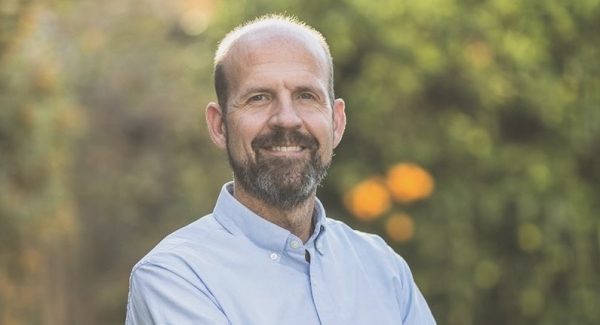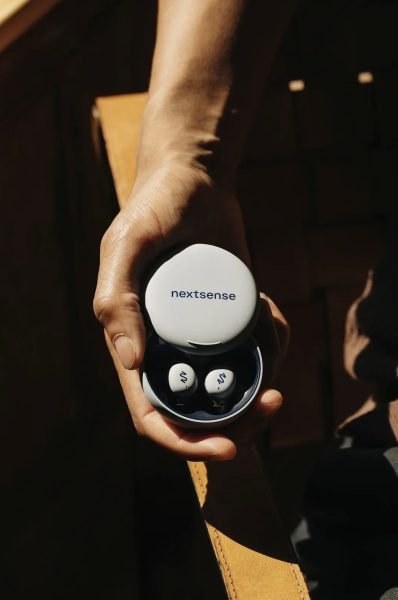NextSense is a U.S.–based neurotechnology company (founded ~2020) that designs wearable devices centred on brain health. They build in-ear EEG earbuds (i.e., earbuds that can measure brain activity via electroencephalography) and a paired software/cloud platform that analyzes the neural signals. Pulse 2.0 interviewed NextSense founder and CEO Jonathan Berent to gain a deeper understanding of the company.
Jonathan Berent’s Background

Could you tell me more about your background? Berent said:
“I’ve taken an unconventional path that bridges entrepreneurship, academia, and big tech. Throughout my career, I have spent over a decade at Google, eventually becoming a Director at X working on moonshot technologies. Along the way, I developed a deep fascination with neuroscience, particularly sleep and altered states of consciousness, which led me to shift toward research. I now lecture at Stanford and UCSF and co-author peer-reviewed papers as well review papers for conferences. That dual lens, operating in both academic and startup environments, gives me a unique ability to translate cutting-edge science into real-world solutions that can scale. That’s exactly what we’re doing at NextSense.”
Formation Of The Company
How did the idea for the company come together? Berent shared:
“The idea for NextSense came together during my time at X, where I was working on moonshot technologies. I’ve always been fascinated by sleep and the brain—topics I’d been exploring personally since college. After leading the Heimdallr project at X, which was focused on technologies beyond the phone that could usher in the next generation of computing, I realized there was potential to give access to the brain that didn’t require a hospital stay or a Phd in neuroscience to understand. As CEO, I oversee our strategy, research partnerships, and product development to close that gap.”
Favorite Memory
What has been your favorite memory working for the company so far? Berent reflected:
“We had our first offsite and Richa Gujarati had just joined us from Apple, where she served as Head of Regulated Health, Product, Partnership & Go-to-Market. She had worked on the product that personally saved my life from a potential stroke – the afib algorithm for the Apple Watch. I was thrilled to have her on the team. She commented after the second day of the offsite how different NextSense culture was. I asked her in a word what describes the culture and why it felt different from the amazing company she had just left. Her word – empowering.”
Core Products

What are the company’s core products and features? Berent explained:
“Our core product is the NextSense Smartbuds, currently available for pre-order. They’re a first-of-their-kind, in-ear EEG device designed to passively collect high-quality brain and sleep data while you sleep—no headbands, no lab visits. They also function as a normal pair of high-quality, totally wireless earbuds like Airpods or Galaxy buds. However, during the day they collect your brainwaves and generate user-specific melodies that are not just pleasing to listen to, they invite deeper states of relaxation and focus. Using the Smartbuds, the user can ultimately have 3 states to choose from – sleep, relax and focus. No other technology offers the same closed-loop enhancement for conscious and non-conscious states.”
“For sleep: by continuously monitoring brain activity in real-time, Smartbuds provide closed-loop feedback, delivering personalized insights that go beyond tracking, actively facilitating deeper sleep and enhancing cognitive function. During deep sleep, we use technology to enhance the quality of the slow oscillations, the pillar of deep, restorative sleep. This is a science-backed technique and unique to a form factor like ours.”
Challenges Faced
Have you faced any challenges in your sector of work recently? Berent acknowledged:
“One major challenge when designing the product is accounting for anatomical diversity- everyone’s ears are built differently. Comfort is critical when you’re asking someone to wear a device overnight. We worked closely with audiologists and ran extensive field testing to ensure the Smartbuds are so comfortable, most users forget they’re even wearing them.”
Evolution Of The Company’s Technology
How has the company’s technology evolved since launching? Berent noted:
“We started with research-grade prototypes that required a small box and a wire between both earbuds. Now we’re on the verge of launching a fully consumer-ready product. Our machine learning algorithms for sleep staging and neural biomarker detection have improved dramatically, thanks to our ongoing research collaborations and real-world testing.”
Significant Milestones
What have been some of the company’s most significant milestones? Berent cited:
“Over the past year, we’ve reached several major milestones that mark our transition from an R&D-centric company to a product-ready, mission-driven team on the verge of commercial launch. Our first milestone was acquiring pharmaceutical companies to back validation studies. We generated over 5.5M in total contract value with four companies. Second, we translated that research into a peer-reviewed publication showing the efficacy of ear-eeg for seizure detection. These were our significant milestones in Season One of NextSense.”
“Season Two, the consumer launch has had other exciting developments. One, hiring a world-class team with consumer product expert engineers, designers, researchers and marketers. Additionally, we have reached mass production of our units. By the time readers are seeing this article, we will be in full production in China, producing 5000 units for the holiday season. It’s a major achievement in a complex category like brain-sensing earbuds, where precision engineering, miniaturization, comfort, and high-quality EEG signal detection all need to work seamlessly together.”
“Our formal launch at CES 2025 was another standout moment. We unveiled our product publicly for the first time, surpassed pre-order goals, and captured significant media attention from outlets like CNET, The Washington Post, and Fox News. We also built momentum at events like SXSW and NFLPA Pitch Day, where we were named a top-3 finalist and formed valuable partnerships with elite athletic organizations.”
“On the clinical side, we’ve expanded research partnerships with Stanford, Harvard, Mayo Clinic, and Emory, contributing not only to validation studies but also generating early revenue. Simultaneously, our sleep and EEG algorithms have reached significant performance milestones, such as achieving 80% accuracy for slow wave detection.”
“Also, we have had strong interest from technology companies, and have visited the HQ of all the major players both in the US and internationally.”
Customer Success Stories
Can you share any specific customer success stories? Berent highlighted:
“We’re looking forward to sharing success stories soon as we begin gathering feedback from our early users. Based on initial interest and internal testing, we anticipate strong engagement and meaningful impact once the program is live.”
Revenue
When asking Berent about the company’s funding details, he revealed:
“Yes – we have audited financials. We began generating revenue in 2022, reaching approximately $1M, and doubled that to $2M in 2023. In 2024 and early 2025, we saw a temporary decline as we made a strategic shift from pharmaceutical to consumer markets. With that transition complete, we anticipate our highest revenue yet in 2025, driven entirely by Q4 sales.”
Total Addressable Market
What total addressable market (TAM) size is the company pursuing? Berent assessed:
“We believe that the broader sleep economy, currently valued at over $500 billion globally, represents our long term opportunity. This includes everything from sleep aids and wearables to diagnostics, data driven coaching and personalized health interventions.”
“In the near term, our focus is on a more targeted segment within the ecosystem: tech forward consumers, biohackers and wellness oriented individuals seeking to improve sleep through measurable brain based insights. When adjusted for this specific demographic and our initial product scope, we estimate our near-term TAM to be in the range of $2 to $3 billion over the next two years. As our platform evolves and we adopt broader consumer health markets, we see significant room for growth within the larger sleep and brain health categories.”
Differentiation From The Competition
What differentiates the company from its competition? Berent affirmed:
“NextSense is uniquely positioned at the intersection of clinical science and consumer health. Most wearables are either highly clinical and inaccessible—or consumer-grade but limited in data quality. We’re the only company offering clinical-grade brain data in a form factor people actually want to wear. That opens up new possibilities not just for better sleep, but for improving cognition, focus, and mental health.”
“Unlike other consumer wearables, Smartbuds analyze your sleep and wake data so you don’t have to. Rather than overwhelming you with a mountain of obscure graphs, the NextSense app delivers intuitive insights related to sleep and focus and actionable advice for how to improve both.”
Future Company Goals
What are some of the company’s future goals? Berent emphasized:
“Our immediate focus is bringing our first product to market and continuing to strengthen the research ecosystem that supports it. Looking ahead, our long-term vision is to pioneer a new category of human-centered technology – what we refer to as the ‘smart human.’”
“As the owners of Tecticoat, the most advanced material for bridging biosignals with AI, we’re uniquely positioned to lead in this space. Our IP portfolio includes foundational patents for smart glasses and smart clothing, opening the door to a wave of next-generation products that can deliver continuous, personalized insights.”
“To illustrate what this could look like in the future, we have created a short concept film titled H3.”
Additional Thoughts
Any other topics you would like to discuss? Berent concluded:
“I’d love to emphasize the larger mission behind what we are building at NextSense. Our goal isn’t just to create another health tracking wearable. It is to unlock a new category of brain-based health insights that are both clinically meaningful and accessible to the everyday consumer.”
“The brain holds the key to understanding everything from sleep quality to mental health and neurological risk, but current tools are either too clinical, too bulky or too inaccessible for most consumers. By combining gold-standard EEG technology with user-friendly designs, we are working to democratize what has been traditionally confined to research labs or hospitals – making it possible for individuals to understand and act on their own brain data on a daily basis.”
“Our long-term vision is to empower individuals with meaningful insights into their cognitive and neurological function, bringing brain health into the same category as heart rate, sleep, and other widely tracked metrics. This has the potential to fundamentally shift how we think about wellness, prevention, and early detection of neurological conditions.”
“Finally, we have a book coming out about NextSense and my journey. It’s tentatively titled Entrepreneurial Dreams written by Michael S. Malone.”


